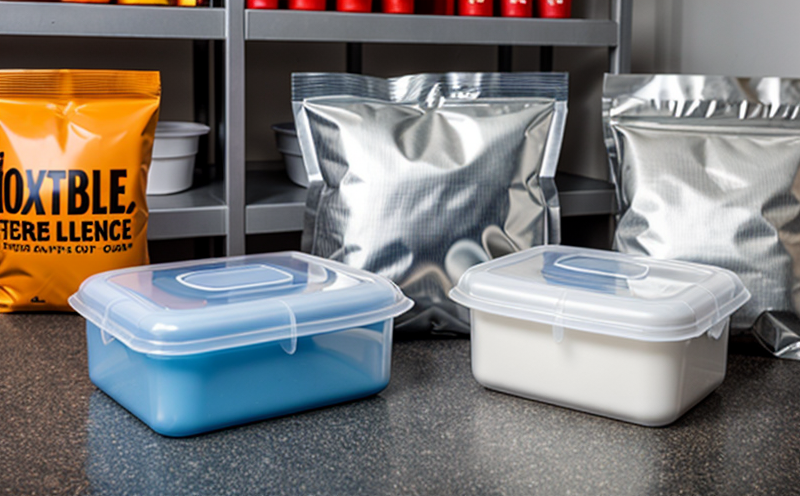ISO 4578 Adhesion Testing of Laminated Films
The ISO 4578 standard provides a method for determining the lap shear adhesion strength of laminates used in flexible packaging. This test is crucial for ensuring that different layers within these materials bond securely, which directly impacts the overall integrity and performance of the packaging.
Flexible packaging often consists of multiple layers designed to protect products against environmental factors such as moisture, oxygen, light, and contaminants. Each layer may serve a specific purpose; for instance, one might provide structural strength while another offers barrier properties. Ensuring that these layers adhere correctly is essential for maintaining the intended functionality throughout the product's lifecycle.
The test involves preparing samples of the laminate according to specified dimensions in ISO 4578:2019(E). Specimens are then clamped into a testing machine and subjected to a controlled loading force until failure occurs. The peak load at which separation between layers starts is measured and reported as the lap shear adhesion strength.
Understanding this parameter helps manufacturers optimize their material selection processes, ensuring that they choose combinations of materials that not only meet required performance levels but also balance cost-effectiveness with quality assurance standards.
- Customer Impact: Reliable measurement ensures better product safety and extends shelf life by preventing leaks or breaches in the packaging system.
- Satisfaction: Accurate data contributes to higher customer satisfaction through improved trustworthiness of products on market shelves.
In summary, ISO 4578 adhesion testing plays a vital role in quality control and compliance with industry regulations. By accurately measuring the bond strength between layers, it supports informed decision-making during product development phases, ultimately leading to more robust and reliable packaging solutions.
Eurolab Advantages
At Eurolab, we bring unparalleled expertise in flexible packaging testing. Our state-of-the-art facilities are equipped with the latest technologies ensuring precise measurements that meet international standards like ISO 4578:2019(E). Our team comprises highly skilled professionals who understand both theoretical aspects and practical implications of various tests.
We offer comprehensive support from initial consultation through final report delivery. This includes detailed guidance on sample preparation, interpretation of results, and recommendations for any necessary adjustments to your current manufacturing processes based on test outcomes.
Our commitment extends beyond just executing the physical test; our goal is to provide valuable insights that contribute towards continuous improvement in your organization’s operations related to flexible packaging design and production.
Why Choose This Test
Selecting ISO 4578 adhesion testing for your laminated films is not just about meeting regulatory requirements; it's also an investment in the future success of your products. Here are several reasons why this particular test stands out:
- Ensures Integrity: By verifying that individual layers adhere properly, you ensure that your packaging maintains its integrity over time.
- Promotes Durability: Strong bonds between layers translate into longer-lasting products, which can significantly enhance customer satisfaction and loyalty.
- Facilitates Compliance: Regular adherence to this standard helps maintain compliance with relevant international regulations.
- Informs Innovation: Test results provide valuable feedback that can drive innovation in your product design and manufacturing processes.
The ISO 4578 test is particularly beneficial because it offers a standardized approach to evaluating adhesion strengths, allowing for consistent evaluation across different materials and manufacturers. This standardization enhances comparability among products and fosters trust within the industry.
Customer Impact and Satisfaction
The impact of ISO 4578 adhesion testing extends far beyond internal processes; it also significantly influences customer experience and satisfaction. Here’s how:
- Better Product Performance: Strong bonds between layers lead to superior product performance, reducing the likelihood of defects that could compromise quality.
- Enhanced Safety: Reliable packaging reduces risks associated with compromised integrity, ensuring safer handling and storage conditions for consumers.
- Increased Trustworthiness: Compliance with recognized standards enhances brand reputation by demonstrating a commitment to high-quality products.
- Sustained Customer Loyalty: Consistently reliable packaging contributes positively towards building long-term relationships with your customers.
By investing in this type of testing, businesses can ensure they are delivering value not only in terms of functionality but also in terms of perceived quality and reliability. This translates directly into improved customer satisfaction levels, thereby fostering a loyal customer base.





